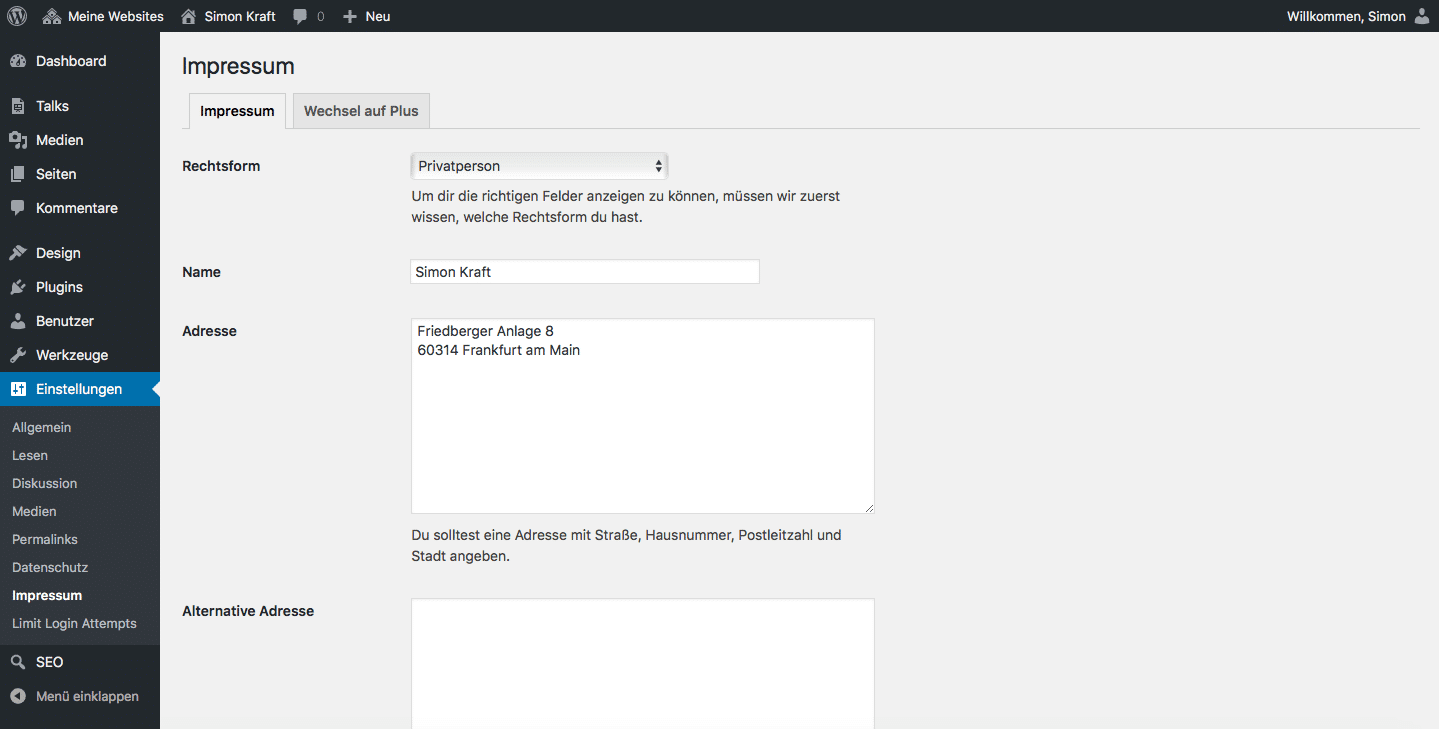It took, believe it or not, 10 years working with (and on) WordPress before I was able to overcome this step. My own plugin in the WordPress.org directory. So it’s about time we talked about “Impressum”.
On a cold day at the end of October 2017 my good friend Matze and I sat together in Stuttgart and had the crazy idea. Let’s “simply” develop a little WordPress plugin. In theory, it sounded relatively easy: a plugin that gets an imprint generator directly into the WordPress backend. But already after a short time it turned out: something like this can either be programmed quickly or correctly, we decided for the latter and in the past half year we have spent a day or two working and several glasses of Mate, Red Bull and Gin on the plugin.
Show and Tell
But before I get into the history of origins for too long, we’d better get straight to the point. The plugin bears the simple name Impressum and can be downloaded from the WordPress.org directory or imported directly via Plugins > Install in the WordPress backend.

In its current version, the plugin provides a complete imprint generator, which offers a number of fields to fill out after the legal form – private individual, self-employed, company, etc. – has been queried. If all necessary fields are filled in, the generated imprint can be displayed anywhere on the page using the [ impressum] short code. The functional range of the plugin is still quite modest for the moment, but a number of other functions are already in the starting blocks for the upcoming versions.
To anticipate a question that is guaranteed to be asked: yes, theoretically I can just use one of the popular imprint generators and save myself another plugin in my installation. But with a plugin we are able to do something that no statically generated imprint can do. Impressum will react to changes. If changes in the law or funny judgments of any courts require crazy changes to the imprint, the plugin receives these changes via an update and can then either propose changes on its own or inform its users that they have to take action themselves.
In times of the GDPR (yes, I said the bad word again) it would of course be irresponsible to publish a plugin that stores personal information somewhere externally. We have therefore packed the entire logic for generating the imprint directly into the plugin, the data never leaves your own WordPress installation – with the exception, of course, of the generated imprint, which will in the end be publicly visible on your site.
Further medium and long-term benefits will hopefully emerge from our plans for the next versions.
Roadmap
So let’s take a look at our internal roadmap. Without revealing too many secrets, I can name three big points on our list for the coming months:
Privacy statement
If you say A, you have to say B. After the imprint comes the question of a data protection generator. Almost without exception, all testers with whom we have spoken in the run-up to this official publication have requested a data protection generator. And indeed: in a preliminary version we already had a working generator for GDPR compliant data protection declarations, supported by our good friend and law expert Udo Meisen (aka PraetorIM).
But there we are again deciding for the “fast” or “right” way to do it. At that time it became apparent that the WordPress core itself would implement a form of data protection generator and we decided to postpone our own development. The current plan is to maybe build on the functionality of the Core and extend it to manage a privacy statement.
The Gutenberg Block
The new WordPress editor is still a long time coming. But it’s almost certain it’ll come. And because our current integration via a shortcode looks like a crutch in the gloss of the Gutenberg editor, there will be no way around an imprint block (and therefore also a data protection block) for the new editor in the future.
Support for distributed systems
I admit that I originally came up with this feature for myself. For home use alone I run about two dozen WordPress installs, of which only a few are in multisite installations (Multisite support has already found it’s way to Impressum in version 0.2). Even one year after my last move I still found outdated addresses and phone numbers on the different pages – a condition that can quickly become expensive.
With the “support for distributed systems” Impressum should be able to obtain the data from a self-defined central source and to keep it up-to-date across countless installations. This is not only exciting for crazy WordPress-folks with unhealthy tendency to pump out projects, but also for agencies and larger companies. And that’s exactly why this feature will probably never find its way into Impressum, but into its big brother, Impressum Plus.
Plus?
Yeah, plus. We decided for this plugin not to go exclusively via the WordPress.org directory. In addition to the (forever) free imprint, there will be another version – Impressum Plus – which will be available for a small payment. In addition to the above, it will have some other features.
The free version can only be used by private individuals and sole traders. If you run a corporation, you must use the Plus version to generate a complete imprint.
Because pricing model will be relatively simple: 5 € per domain and year for updates and support. For users with many sites, such as agencies or me, there will also be a volume license at an even lower price. In the context of the total running costs of a site, this amount should be practically not existent. Even though paid plugins are no longer rare these days, this step is still so unusual that I would like to explain it at least briefly.
Just because we have developed Impressum in our spare time, on holidays, weekends and on vacation, there is a lot of passion, time and also a little money in this plugin. Motivation for continuous development comes largely from working with the community, feedback and ideas from various users. At the end of the day, however, an additional source of income helps a lot to secure the necessary time for further development.
Impressum Plus is currently still in the starting blocks and will hopefully see the light of day in the next few weeks, but by then the free version is already available on WordPress.org.
Epiphyt
Because we also have a colorful bunch of other ideas on our list, Matze and I went one step further and started a small plugin forge. As Epiphyt we want publish some small plugins to support the community.
For the moment you will find a few sentences about Epiphyt and an absolutely worth subscribing newsletter about all innovations around Impressum and the other planned plugins at epiph.yt.

Why Epiphyt? I’m glad you asked. Some important factors have played a role for us in the choice of names. Epiphytes are plants that grow on other plants. Classic examples from more tropical regions of the world are bromeliads and many orchids. Many of you might be more familiar with the mistletoe. Similar to how these epiphytic plants often sit on trees, WordPress plugins are based on the WordPress core. 🤓
Can ‘Impressum’ also cover for special cases such as healing professions, craftsmen …
Hi, Pit,
very good question. Not at the moment, but we have the function on our roadmap and are already considering how and where this could best be implemented.
I recommend our Newsletter, if you want to stay informed about these (and other) new features 🙂